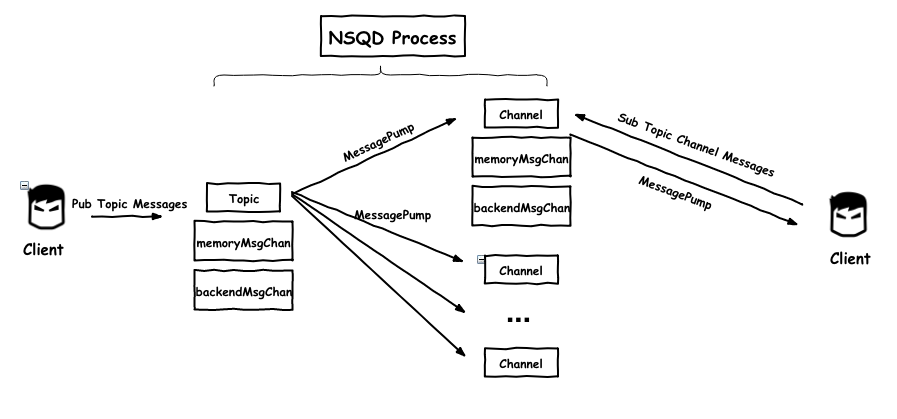NSQD 消息处理整体流程

memoryMsgChan 和 backendMsgChan
memoryMsgChan:为内存缓冲区,Topic和Channel内存缓冲区的大小可以通过同一变量mem-queue-size来进行配置。
backendMsgChan:为磁盘优先级队列。通过diskqueue来实现。发送到backendMsgChan中的消息会通过diskqueue写入到磁盘中。
生产者
作为消息队列的生产者,可以通过HTTP、TCP两种方式向NSQD生产消息。但两种方式相同的是,需要指定生产消息的Topic。
NSQD在接收生产者发送过来的消息的时候,会优先将消息写入Topic的内存缓冲区(memoryMsgChan)中。
如果生产者生产消息的速度过快,或者消费者消费不及时导致memoryMsgChan中的消息积压。当memoryMsgChan已经满了的时候,生产者会直接通过backendMsgChan将数据直接写入磁盘。
NSQD在接收生产者发送来消息的时候,一部分存储在memoryMsgChan、一部分存储在backendMsgChan,其中memoryMsgChan、backendMsgChan中的消息之间保持着原有的先后顺序,但是memoryMsgChan和backendMsgChan之间消息就丢掉了相互之间的先后顺序。所以,NSQD本身是不保证消息的有序性的。但是消费者可以通过消息的ID和时间戳来判别消息之间的先后顺序。
消费者
作为消息队列的消费者。通过和NSQD建立TCP连接,就可以订阅指定Topic的消息进行消费。在订阅消息的时候,需要指定Topic和Channel两个参数。
NSQD在接受到来自消费者的SUB(订阅)请求后,会找到指定Topic下的Channel,若Channel不存在,则会创建一个新的Channel。并通过Channel中的 memoryMsgChan和backendMsgChan向消费者发送消息。
消费者优先消费memoryMsgChan中的消息。
如果消费者消费消息的速度过快,或者生产者生产不及时导致memoryMsgChan中没有数据。消费者会通过backendMsgChan直接消费存储在磁盘上的数据。
NSQD
在上述流程中,NSQD负责消息接收、消息发送,以及维护Topic和Channel之间映射关系的功能。其中重要的一环是消息如何从Topic流向Channel。
生产者在生产消息的时候,是以Topic为目标来进行生产的;消费者在消费消息的时候,是以Topic和Channel为目标来进行消费的。所以NSQD中,Topic在接收到生产者消息后,会不断的将消息分发给其下面的各个Channel。
同样也是内存优先的策略。
- 如果是 Topic 的memoryMsgChan中有消息,Channel的memoryMsgChan中有空位,则直接Topic memoryMsgChan -> Channel memoryMsgChan。
- 其次是 Topic memoryMsgChan -> Channel backendMsgChan 或者 Topic backendMsgChan -> Channel memoryMsgChan
- 最后是 Topic backendMsgChan -> Channel backendMsgChan
即使没有消费者或者生产者的存在,只要Topic和Channel存在,上述过程也是在不断的进行当中的。直到Topic中的消息完全分发给下面所有的Channel。
历史消息问题
在NSQ中,新的消费者是无法重新消费到已经被消费的消息,即使创建了一个新的channel。
因为消费者消费的消息来自Topic的memoryMsgChan和backendMsgChan。而Topic不会记录其下各Channel消费消息的位置。
所以当consumer启动之后,只能消费到新增消息,不能消费到历史消息。
NSQD 消息处理相关源码分析
这一部分主要说明NSQ消息传递相关的业务逻辑:生产者 -> NSQD -> 消费者。NSQD启动后会初始化HttpServer和TcpServer,来接收客户端请求。这里以TcpServer为例。
NSQD接收客户端连接
每当有一个客户端通过TCP的方式连接NSQD,都会通过IOLoop对客户端发送的命令不断进行处理。
1 | // protocol v2 处理客户端请求 |
客户端向NSQD发送写命令
在上述代码中,NSQD会对客户端发送的命令进行解析并执行。下面来说明,当客户端向NSQD发送PUB/MPUB命令时的一些操作。
1 | func (p *protocolV2) PUB(client *clientV2, params [][]byte) ([]byte, error) { |
上述代码中很关键的一个环节就是 topic.PutMessage(msg),下面来说明它的具体实现。
1 | /* 通过下面的方法,会将message写入Topic的memoryMsgChan或者backendMsgChan中, |
客户端向NSQD发送读命令
同理,在NSQD收到客户端发来的SUB请求时,
1 |
|
上述代码的主要工作,就是在接收到SUB命令时,创建或者获取相应的Topic和Channel,并最终把channel写入到client.SubEventChan中。
1 |
|
NSQD中消息从Topic流向Channel
只要存在Topic和Channel并且不处于暂停状态,Topic下面的Message会通过下述方法不断的写入到Channel中。
1 |
|